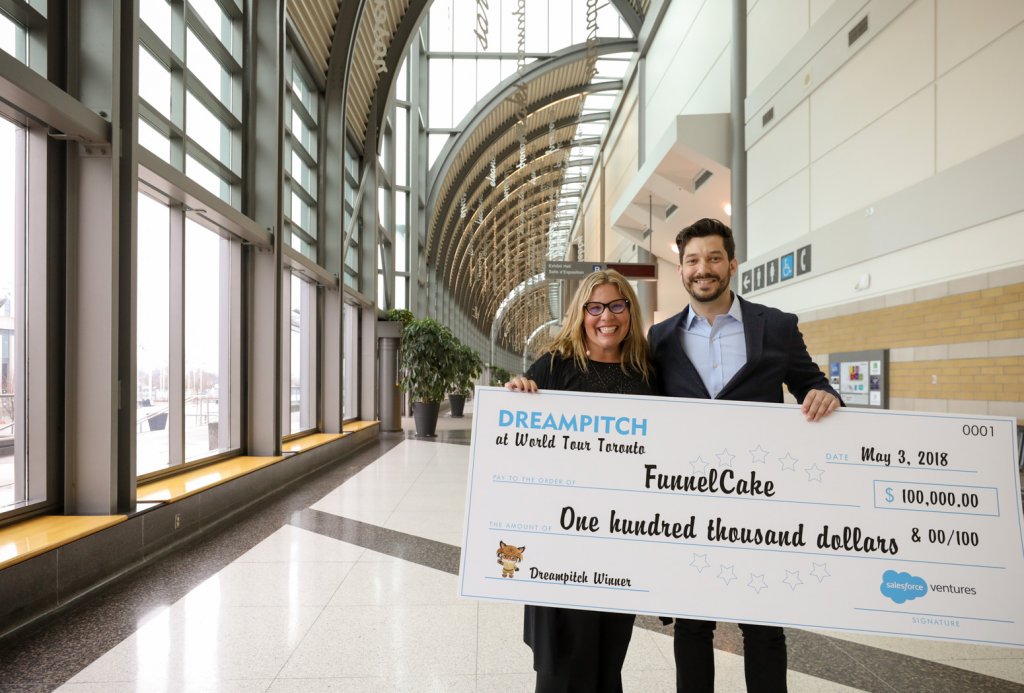FunnelCake is Fixing How Teams Work Together
“We’re always pushing to make things bigger because we have a huge vision for the future.”
As most inspiring entrepreneurial stories go, this tale begins with a Legend of Zelda: Ocarina of Time fan website. That was the first project Marko Savic built as a kid, way back in 1998. Now, 13 Zelda game releases later, Savic is the CEO of FunnelCake, the rapidly-growing, Dreampitch-winning startup he founded in 2015 to solve the decidedly un-video-game-like problem of sales and marketing losing communication with one another.
Savic took a slightly different route to start his tech company than most do. He graduated from the acclaimed York-Sheridan design program and moved back to his hometown of Kitchener-Waterloo after university to work as a creative director at PineLake. That agency quickly grew from five to 50 employees before Savic wanted to be a part of an in-house team. By the way, it may be wise to keep that idea of brisk expansion closeby when talking about Savic’s career—things move quickly.
Savic joined Igloo Software, again as a creative director, and saw that team triple in size over his three-year tenure. His role mainly involved marketing and sales operations this time around, and this is where Savic first saw the problem he would solve with FunnelCake. This is where that first idea to break off and make a new company came from, even though that idea to create had been around since his youth.
“I’ve always wanted to build a product, so I’m fascinated by them,” says Savic. “When the iMac came out I was obsessed with it. I always wanted to think about building something that changes the way people work. I’ve always followed that idea in my spare time.”

A peek inside Communitech, FunnelCake’s home.
The problem Savic encountered arose when marketing ran into problems with sales. Demand generation would create possible leads, but sales would have no idea if they were qualified or worth pursuing. Marketing would then check in to see if leads had been picked up, resulting in an eternal struggle. “Always a battle,” as Savic looks back on it.
So that left Savic to mediate between the two teams, and that involved dredging up Salesforce data to prove what was really happening. That process of data discovery took up to two months at a time—not exactly the definition of agile. There had to be a better way to find the right data all within the easily-available Salesforce platform.
“When I went out looking for a tool, I couldn’t find anything.”
“It was a really interesting problem so I wanted to see if a business could happen there,” says Savic. “Really from the technical experience, it’s about taking the complex problem we’re trying to solve and figuring out what the right user interface layer to put on it.”
Savic knew he had an idea, so he consulted with Igloo’s board members for advice. They suggested he do customer diligence interviews, so he set out and asked over 100 people in the field. After a six-month discovery process, he began hearing the same pain points from people that he had already documented.
Savic founded FunnelCake in 2015 with Andrew Lawton, who has since amicably parted ways with the company. The company got off the ground with a friends and family seed round, which they used to bring on pilot customers. With feedback from that original beta, FunnelCake raised another round, this time with help from MaRS IAF and BDC. FunnelCake set up shop in Communitech, the hub for innovation in Kitchener-Waterloo.
“I used that to say this is something I care deeply about, something I can get nerdy about for the next 10 years, and there’s a huge market to build the business around,” Savic explains regarding the earliest days of FunnelCake.

Savic holding his Dreampitch winnings with host Leyla Seka, the EVP of Salesforce’s AppExchange.
There were a lot of hurdles to get past as a first-time founder. Coming from a creative background, Savic had to learn what being a product manager meant, how to be a salesperson, a CEO, and how to manage finances. The most difficult aspects came from learning how to manage emotions and how to stick to a vision while also letting in customer feedback.
“As a startup founder you need to learn every single discipline within the company and get it to a point where you can hand it off to someone else,” says Savic.
“That learning has been incredible and it made me a far better person, and it’s something that can’t be taught anywhere else.”
A big part of how the company has grown so quickly involves Savic and FunnelCake’s continued dedication to hands-on customer service. It only takes five minutes to get fully connected and customized with FunnelCake through Salesforce, then the team will train sales, operations, leadership, and anyone else who wants to use the platform.
“Hands on leads to huge adoption and rapid success within these organizations,” says Savic.
FunnelCake beats out competitors by offering the full funnel experience, an implementation that can change a business from the bottom up. The moment Savic really knew that FunnelCake had made it was when they published their case study for Auvik Networks. Auvik had been using FunnelCake since the beginning and had gotten to the point of advocating for the platform, but only in December 2017 did they let the company publicly share the true scope of their help.
Auvik—who coincidently just raised a huge $20 million funding round—doubled their lead-to-revenue conversion rates and saw a 90 per cent reduction in sales process violations, both of which are company-changing metrics. All thanks to FunnelCake.
There’s room to go still though. With the big Dreampitch win at Salesforce’s World Tour Toronto, FunnelCake is firmly on the radar of some big players, but they still want to expand into Salesforce’s AppExchange and foster one-click installs. More funding rounds involving some capital from the government of Canada may also be on the horizon.
The vision runs deeper.
“Our goal is to fix the complicated relationships between teams at work.”
“Right now that’s between marketing, sales and customer success,” says Savic. “The same issues happen with support teams, technical teams, and anywhere there’s a handoff. I think we can expand to solve that broader problem and make a large successful company out of that. Essentially, how do you bring transparency across all lines of business?”
That might be a trick. Savic knows the answer and will continue his push to bridge the gap between working teams—and no, it doesn’t involve The Legend of Zelda.
from Techvibes


